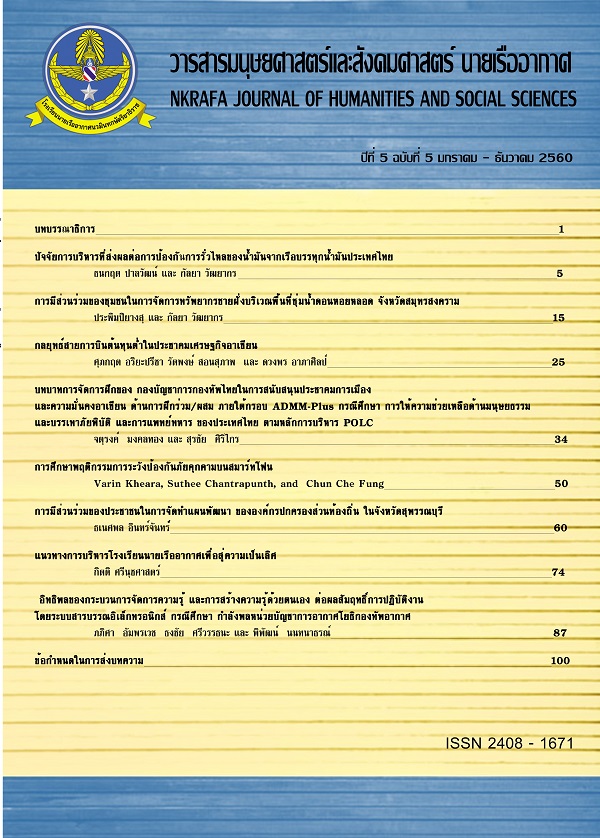The Strategy of Low-Cost Airlines in ASEAN Economic Community
Main Article Content
Abstract
This study aims to explore rationale for the establishment of low-cost airlines as well as successful competitive strategy of low-cost airlines in the ASEAN Economic Community to enhance understandings of proper strategy for low-cost airlines. The research is qualitative and an in-depth unstructured interview is used to gather data. The analyses are of two kinds 1) business approach which include SWOT (Strengths, Weaknesses Opportunities, Threats) analysis and five forces model and 2) cultural approach. The scope of study is four low-cost airlines: Southwest Airlines, Jetstar Airways, Thai Air Asia, and Nok Air.
The results show that the reason to establish low-cost airlines include 1) As an alternative for the travel of the public. 2) To expand the business base of the major airlines. 3) In response to tourism and business in the era of globalization. 4) Travel Culture that demands speed and economy. The successful competitive strategies of low-cost airlines in the ASEAN Economic Community include 1) Low price fixing to attract passengers to continuously use the services. 2) Purchasing new aircraft of a single type in large numbers to lower operation costs. 3) Opening routes that are competitive to serve an expanded customer base. 4) Partnering of low-cost airlines with investors abroad. 5) Adding value to customers in terms of safety, punctuality, and convenient services. 6) Creating relationships between different cultures in organizations to achieve the same goals.
Article Details
บทความที่ได้รับการตีพิมพ์เป็นลิขสิทธิ์ของวารสารมนุษยศาสตร์และสังคมศาสตร์ นายเรืออากาศ
ข้อความที่ปรากฎในบทความแต่ละเรื่องในวารสารวิชาการเล่มนี้ เป็นความคิดเห็นส่วนตัวของผู้เขียนแต่ละท่าน ไม่เกี่ยวข้องกับโรงเรียนนายเรืออากาศฯ และคณาจารย์ท่านอื่น ๆในโรงเรียนนายเรืออากาศฯ แต่อย่างใด ความรับผิดชอบขององค์ประกอบทั้งหมดของบทความแต่ละเรื่องเป็นของผู้เขียนแต่ละท่าน หากมีความผิดพลาดใด ๆ ผู้เขียนแต่ละท่านจะรับผิดชอบบทความของตนเองแต่เพียงผู้เดียว
References
[2] สายการบินนกแอร์. แบบแสดงรายการประจำปี 2558 (แบบ 56-1). กรุงเทพฯ: บริษัท สายการบินนกแอร์ จำกัด (มหาชน), 2558
[3] ผู้จัดการสุดสัปดาห์. “ประเมินศักยภาพการบินอาเซียน ฤาสายการบินแห่งชาติพ่าย Low Cost.” [ออนไลน์] เข้าถึงได้จาก: http://www.manager.co.th/AstvWeekend/ViewNews.aspx? NewsID=9580000092337., 4 มีนาคม 2559.
[4] วีรยุทธ ดิษยะศริน. “การพัฒนาอุตสาหกรรมการบินเพื่อเตรียมความพร้อมสู่ประชาคมอาเซียน.” วิทยานิพนธ์ศิลปศาสตรมหาบัณฑิต, สาขาวิชาผู้นำทางสังคม ธุรกิจ และการเมือง วิทยาลัยนวัตกรรมทางสังคม, มหาวิทยาลัยรังสิต, 2557.
[5] Hofstede, G. Dimensionalizing Cultures: The Hofstede Model in Context. Online Readings in Psychology and Culture, 2(1). http://dx.doi.org/10.9707/2307-0919.1014. 2011. Humphrey, A. “SWOT Analysis for Management Consulting” (PDF). SRI Alumni Newsletter: SRI International. 2005.
[7] Jetstar Airways. “Jetstar Airways.” [Online] Accessed from: http://www.jetstar.com/th/th/about-us/jetstar-group/jetstar-airways., 28 October 2015.
[8] Khee, Alan – TAN, Jin. Toward a Single Aviation Market in ASEAN: Regulatory Reform and Industry Challenges. Faculty of Law, National University of Singapore .2013.Porter, M.E..Competitive Strategy Techniques for Analyzing Industries and Competitors. New York: The Free Press. 1985.
[9] Southwest Airlines. “Southwest Airlines – A Brief History.” southwest.com., Southwest Airlines Co. 2009. Archived from the original on August 18, 2010.
[10] Sosa ,Aileen. ASEAN Single Aviation Market. Philippine Civil Aviation Policy Paper,the Philippine Bases Conversion Development Authority (BCDA), March 28,2007.
[11] Thomas, Ian and Others. Developing ASEAN’s Single Aviation Market and Regional AirServices Arrangements with Dialogue Partners . REPSF II Project No. 07/003 2008.


